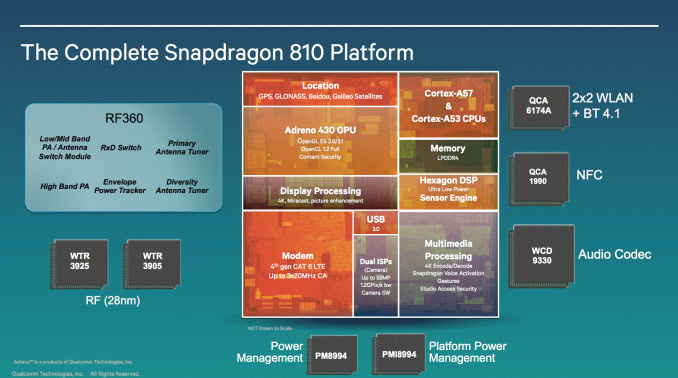Affiliate links on Android Authority may earn us a commission. Learn more.
More rumors surface regarding Snapdragon 810 overheating issues
January 8, 2015

The newly unveiled LG G Flex 2 isn’t just a smartphone for display buffs, the handset is also packing Qualcomm’s latest and greatest 64-bit Snapdragon 810 processor. However, all may not be well with Qualcomm’s latest high-end SoC, as more rumors have surfaced suggesting that the chip is struggling with some performance impacting production issues.
As a quick recap, the Snapdragon 810 features eight CPU cores in a big.LITTLE configuration, arranged as four heavy lifting Cortex-A57s and four energy efficient Cortex-A53s for the less demanding background tasks. The SoC also showcases Qualcomm’s new high-end Adreno 430 GPU, which is supposed to be the company’s fastest graphics chip yet. This is also Qualcomm’s first 20nm Snapdragon, manufactured by TSMC, which is an important point to remember later on.

Back to the issues, sources from Korea and analysts with US investment firm J.P. Morgan are convinced that the Snapdragon 810 is suffering from crippling overheating issues. Apparently, this problem is caused by the high-performance Cortex-A57 cores overheating when clock speeds reach 1.2 to 1.4GHz, which is a surprising problem for a core designed to run at speeds approaching 2GHz. This then causes the chip to throttle back on performance, to prevent the whole system from overheating. Separate issues with the SoC’s memory controller have also been reported and instances of GPU throttling have also apparently cropped up during benchmarks, although this could be part of the same CPU overheating issue.
QCOM’s new 64-bit Snapdragon 615 and 810 chips are suffering from overheating issues … For the Snapdragon 810, we believe the issues are related to the implementation of new 64-bit ARM cores (A57) – J.P. Morgan analysts
However, Samsung’s Cortex-A57 powered Exynos 5433 does not suffer from overheating issues, suggesting that this is a problem specific to Qualcomm’s Snapdragon design rather than a problem with the Cortex-A57 itself. This leaves the finger pointed at Qualcomm and TSMC’s 20nm chip design, with several analysts suggesting that a “redesign of a few metal layers” may be needed to fix the issue.
We know that TSMC had been struggling with its 20nm technique for some time and, as this is Qualcomm’s first attempt at a 20nm design, it is possible that unanticipated defects may have appeared. Heat is a serious potential issue when combining high-performance CPU and GPU components into such a confined space, and four Cortex-A57s and the new Adreno 430 may have pushed the chip’s heat up above what we have seen with the older Snapdragon 8XX series and newer low-power Cortex-A53 Snapdragon 615.
During our own hands-on time with the LG G Flex 2 we ran a quick AnTuTu benchmark, which scored an underwhelming result of 41670, placing it behind existing Snapdragon 800 processors. We expected the G Flex 2 to post a result closer to the Galaxy Note 4 and Meizu MX4, which are both octa-core devices powered by some of ARM’s higher end Cortex-A17 and A57 cores.A closer inspection of the results suggests that most of the performance troubles stem from the CPU side of things, with Single Thread and Multitasking scores falling well behind rival Cortex-A57 and A53 based SoCs and even failing to match the performance of older Snapdragon 600 handsets. CPU throttling, possibly due to high-temperatures, is certainly a plausible explanation for such a large performance gap. Although, this could also be a result of optimization issues with big.LITTLE resource management, an unfinished kernel, or some resource hungry background task.While we weren’t expecting a finished article with the G Flex 2, as LG would likely be pushing for optimizations before the handset goes on sale, these results seem to suggest that something was not quite right with the unit that we tested. The GPU score is a little more in-line with expectations, although the Adreno 430 should outpace the Snapdragon 805’s Adreno 420. The GPU result is more likely down to variance and pre-release optimizations, while it’s much harder to explain away the oddly poor CPU result.
If these performance issues turn out to be true, a delayed release of its flagship Snapdragon 810 SoC is going to cause major headaches for Qualcomm. J.P. Morgan analysts expect that a 20nm redesign could take up to three months. One for prototyping and redesigning the problematic metal layers in the chip and another two for “completing the metal mask layers in final production”. This means that the Snapdragon 810 may not be available until mid-Q2 2015, although it is possible that TSMC is already part way through a redesign.
We believe fixing the issues with the 810 will require the redesign of a few metal layers of the chip, which could push out the schedule by about three months, by our calculations (one month for prototyping and design fix and two additional months for completing the metal mask layers in final production). – J.P. Morgan analysts
Qualcomm’s 20nm Snapdragon 808 could fill in during the 810’s absence, providing that it isn’t facing similar issues. However, with NVIDIA, MediaTek and Samsung all offering high-end mobile SoCs with similar capabilities to Qualcomm’s high-end chip, smarphone and tablet manufacturers may turn to Qualcomm’s competitors to power this year’s early flagships. Worryingly, industry wide launch dates could end up postponed as a result.
Previously, Qualcomm had denied rumors of overheating problems in its Snapdragon 810 and has not commented on the latest batch of rumors. Remember, this is only speculation from a small number of sources. It is still possible that Qualcomm will ship the Snapdragon 810 on time and without defects. We’ll keep our eyes pinned for more details.